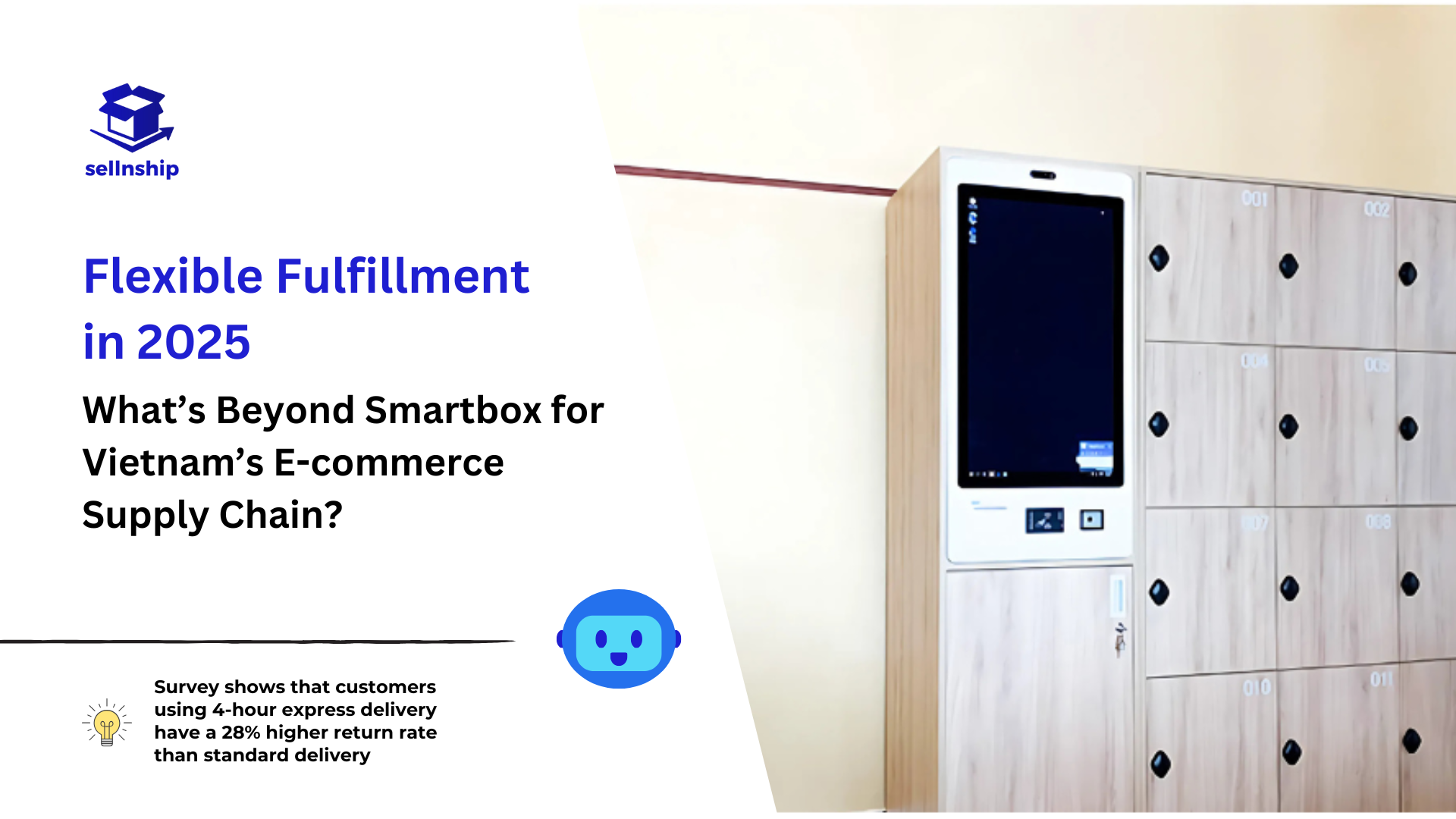Flexible Fulfillment in 2025: What’s Beyond Smartbox for Vietnam’s E-commerce Supply Chain?

In the context of Vietnam's booming e-commerce (e-commerce) landscape, delivery speed and customer experience have become critical factors in determining customer loyalty. Shoppers no longer just expect fast delivery but also demand flexibility – from choosing specific time slots and contactless delivery to picking up orders at self-service points. Flexible delivery is no longer a competitive advantage but a mandatory standard. This article analyzes the importance of flexible delivery, popular models in Vietnam, and how small and medium-sized enterprises (SMEs) can implement it effectively.
Why Is Flexible Delivery Important?
New Consumer Expectations
Post-COVID-19, online shopping behavior in Vietnam has undergone significant changes. According to the Vietnam E-commerce Report 2025 by VECOM, 72% of customers expect the option to choose specific delivery time slots, and 58% prefer contactless delivery for safety and convenience. Major players like Shopee, Tiki, and Lazada have set new standards with services such as “TikiNOW 2H” or “Shopee Xpress Instant” (delivering within 3–4 hours in major cities). This has led customers to expect similar speed and flexibility from all sellers, including SMEs.

Enhancing Brand Loyalty
Flexible delivery options not only meet customer needs but also enhance their experience:
- Reduces failed deliveries due to absent customers.
- Increases convenience and reduces hassle, leading to higher ratings on e-commerce platforms.
- A seamless experience boosts repeat purchases and brand referrals.
A 2025 Shopee survey revealed that customers using 4-hour express delivery services are 28% more likely to return for future purchases compared to those using standard delivery.
Market Data Confirms the Trend
Market data reinforces the importance of flexible delivery:
- 45% of TikiNOW orders in 2024 opted for same-day delivery or specific time slots.
- The share of non-cash payments on e-commerce platforms rose from 25% (2020) to 48% (2025), facilitating contactless delivery.
- According to iPrice forecasts, by 2026, 80% of orders in major urban areas like Ho Chi Minh City and Hanoi will demand flexible delivery.
Popular Flexible Delivery Models in Vietnam
Same-Day and Time-Slot Delivery
Delivery by specific time slots (morning, afternoon, evening) or same-day delivery is highly popular. Notable examples include:
- TikiNOW: Delivers within 2 hours in Ho Chi Minh City and Hanoi, with fixed time-slot options.
- Shopee Xpress Instant: Delivers within 3–4 hours in urban areas, allowing flexible address changes.
- AhaMove: Supports businesses with scheduled deliveries, ideal for sellers managing their own warehouses.
Benefits: Reduces failed deliveries and provides a “order today, receive today” experience.
Challenges: Requires an order management system (OMS) for real-time tracking and significant coordination resources.
Contactless Delivery
Contactless delivery remains popular due to its convenience and safety. Customers pay via digital wallets (MoMo, ZaloPay) or QR codes, with couriers leaving packages at doors or in smart lockers, and customers retrieving them using OTP codes. Platforms like Shopee Xpress, Lazada Logistics, and VNPost support this model. According to VECOM 2025, 60% of customers prefer contactless delivery for fast-moving consumer goods (FMCG).
Pickup Points and Smart Lockers
The hybrid model (combining home delivery and self-pickup) is growing rapidly:
- Viettel Post SmartBox: Allows 24/7 pickup and drop-off, ideal for busy residents in apartment complexes.
- Shopee/Lazada Pickup Points: Optimizes last-mile delivery costs by consolidating orders at designated locations.
Benefits: Reduces individual delivery costs and increases customer convenience.
Challenges: Requires infrastructure investment and partnerships with logistics providers.
How Can SMEs Implement Flexible Delivery?
Technology and Systems Needed
To implement flexible delivery, SMEs need to invest in:
- OMS/WMS Systems: Synchronize inventory and allow customers to select delivery time slots.
- Transport API Integration: Connect with GHN, GHTK, or Viettel Post to offer multiple delivery options.
- Optimized App/Website: Clearly display delivery options to avoid confusion.
Suggestion: Learn more about how AI optimizes delivery routes in the article AI Drives Sustainable Logistics.
Operational and Cost Challenges
SMEs may face challenges such as:
- Coordination Costs: Multiple time-slot options increase operational complexity.
- Overload Risks: Suboptimal systems can lead to delayed deliveries, reducing customer satisfaction.
Solution: Adopt route optimization technology and use multi-hub models (mini-warehouses) to shorten delivery times.
Effective Implementation Roadmap
SMEs should follow these steps:
- Small-Scale Testing: Implement flexible delivery in 1–2 urban areas, measuring feedback and delivery success rates.
- Process Optimization: Adjust routes and set cut-off times (e.g., orders before 10 AM delivered same-day).
- Scaling Up: After achieving ROI and reducing costs, expand to other provinces, incorporating smart lockers/pickup points.
Flexible delivery is not just a trend but a mandatory standard in Vietnam’s e-commerce landscape. Businesses that adopt it early will increase order completion rates, build trust, and foster customer loyalty. With the support of technology and logistics partners, SMEs can compete with industry giants in the race for superior customer experience. Start small, optimize gradually, and turn flexible delivery into a strategic advantage!